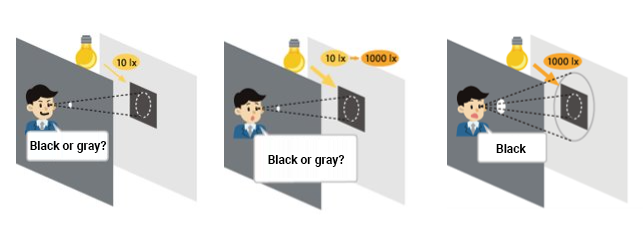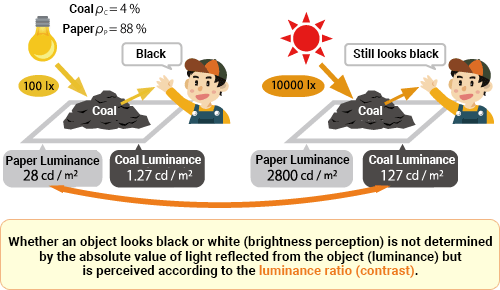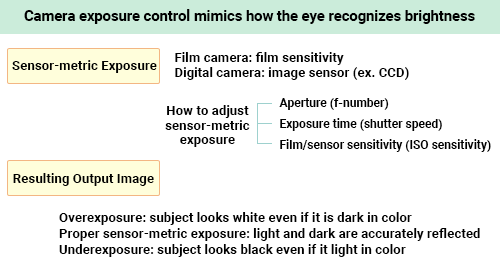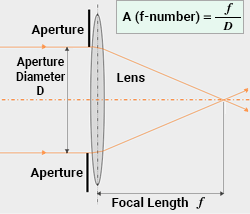Theory of Light and Color

19. The Human Eye and the Camera Eye (Part 2)
Black vs. White to the Human Eye and Proper Camera Exposure
In this and the next chapter, we will compare the mechanism of human perception of lightness and darkness and camera exposure control in more detail.
Recognizing Light and Dark Relative to the Luminance Ratio (Contrast)

For humans, recognizing brightness as black or white is not as simple as the amount of stimulus the photoreceptors receive. Consider a piece of black paper on a white wall in a closed room that is illuminated with an illuminance of 10 lx. Looking through a hole that only shows the paper and not the surrounding wall, a person can tell the paper is dark, but they cannot distinguish if it is black or gray. A brighter light source does not help the eye make this distinction. Only by increasing the field of view so that the white wall is visible can the eye recognize that the paper is black.
Now imagine a piece of coal on white paper illuminated by a light source with an illuminance of 100 lx. As discussed in Chapter 9, the human eye judges brightness based on luminance. Under the same illuminance, the luminance of a surface is proportional to its reflectance (see Chapter 10). On the other hand, if the reflectance value is fixed, the luminance of the surface is proportional to the illuminance. ≪1≫ So if the reflectance of coal and paper is ρC = 4% and ρP = 88%, respectively, the luminance of the paper (28 cd / m2) is ρP / ρC = 22 times greater than that of the coal.

If the light source is 100 times brighter (10000 lx), the luminance also increases to 127 cd / m2 for the coal and 2800 cd / m2 for the paper. Although both have greater luminance, there is still a 22x difference in brightness. So when we naturally recognize the coal as black and the paper as white, it is because of the relative luminance ratio (contrast), not the absolute value of luminance.
Physiological Control of Pupil Diameter and Photoreceptor Sensitivity
The luminance ratio of coal to paper that is incident to the eye is not directly related to the illuminance of the light source. Instead, physiological feedback adjusts eye sensitivity according to the highest and lowest luminance levels within the field of view.
As explained in the last chapter, the human eye does not have a wide dynamic range for brightness. In response to stronger incident light, the pupil shrinks, which reduces illuminance on the retinal surface. Physiological feedback also reduces the sensitivity of photoreceptor cells to ensure an overall dynamic range in response to the brightness of the field of view. The upper and lower ends of the sensitivity range adjust according to the highest and lowest luminance levels in the field of view, respectively.
If the contrast in the field of view is too large, physiological feedback cannot adjust the sensitivity range (like when looking at a very glossy reflecting surface). It will feel too bright because the highest level of luminance exceeds the sensitivity range of the eye.
Camera Exposure Control
Automatic exposure control in cameras is based on the eye. Functionally, the aperture of the camera and the sensor are equivalent to the iris and the retina of the eye, respectively. ISO sensitivity corresponds to the sensitivity of photoreceptors.
In a camera, sensor-metric exposure is determined by the product of the illuminance on the imaging surface (controlled by the aperture) and the exposure time (controlled by the shutter). ≪2≫ By changing the aperture and exposure time, you can adjust sensor-metric exposure to fall within the dynamic range of the sensor sensitivity. A sensor with a different sensitivity will require a change in sensor-metric exposure.

Shutter speed control is a function for determining light and dark that is unique to cameras. As mentioned above, the eye physiologically adjusts the pupil diameter and the sensitivity level of the photoreceptors according to the highest and lowest luminance levels in the field of view.
Camera Exposure Control Parameters
Four factors determine the exposure of the camera:
- 1. Luminance of the subject: B [ cd / m2 ]
- 2. Aperture value (f-number): A
- 3. Exposure time: T [sec]
- 4. Sensor sensitivity: Sx

The luminance of the subject (B) depends on the light source, subject, and camera (brightness of the light source, relative position, properties of the subject, etc.). Once these conditions are set, the camera cannot control the subject luminance by itself. ≪3≫
The simplest illustration of this is how a camera controls these conditions to achieve the correct exposure with continuous light, where brightness is constant during image capture (the luminance of the subject is fixed).
Correct Exposure for Imaging with Continuous Light
Exposure control is the process of determining the right combination of A, T, and Sx so that Q1 = Q2 for a subject with luminance B. The quantity of light Q1 that directly contributes to sensor exposure is the product of the illuminance E (= constant) of the sensor surface and the exposure time T.
Q1 = E・T
The illuminance E of the sensor surface is a function of luminance B reaching the sensor surface through the lens aperture (aperture value A), expressed as ≪4≫
 (k1: constant)
(k1: constant)
Therefore, the sensor-metric exposure Q1 is

To get the appropriate exposure using a sensor with sensitivity Sx, the necessary sensor-metric exposure Q2 is
 (k2: constant)
(k2: constant)
The higher the sensitivity Sx, the less quantity of light is required to get the proper exposure for an image.
In other words, you achieve proper exposure if Q1 = Q2, or

Cameras can perform automatic exposure control by measuring brightness in one of two ways. Reflective exposure control measures the luminance B of the subject when viewed from the camera side. Incident exposure control measures the brightness of the light source (illuminance I of the subject surface). Reflective exposure control is similar to how the eye determines light and dark (black and white).
In the next section, we will discuss how the camera controls exposure based on reflected and incident light to achieve proper exposure conditions.
Comment
≪1≫ Reflectance
Here, we use the more familiar term reflectance, but technically it is the luminance factor. Please refer to Comment ≪2≫ in Chapter 10: The Relationship Between Illuminance and Luminance on Reflecting Surfaces.
≪2≫ How to adjust the sensor-metric exposure of a camera
This explanation focuses on the sensor-metric exposure of silver halide film, which has only two control factors for simplicity (despite being an older medium). In both film and digital cameras, the image surface illuminance depends on the aperture, and the exposure time depends on the shutter. The difference is in sensor sensitivity.
Silver halide film has a fixed sensitivity, so exposure can only be controlled by the aperture and the shutter. If the image is too dark even when using the fully open aperture and the longest exposure time, you need to use a more sensitive film.
On the other hand, digital cameras can electrically control the sensor sensitivity. Thus, there are three ways to adjust exposure: the sensor, the aperture, and the shutter.
≪3≫ Subject brightness B
When the subject luminance is too low (too dark) for the sensitivity level of the camera, one way to increase it and achieve proper exposure is by using a flash synchronized with the exposure time. The next chapter discusses this in more detail.
≪4≫ Relationship between aperture value A and sensor-metric exposure Q1
The aperture value A is the same as the f-number of an imaging lens. The f-number is a value determined by aperture diameter (effective diameter D) and focal length f. The wider the aperture, the smaller the aperture value because A (f-number) = f / D.
The luminous flux (passing through the lens) that determines exposure is proportional to the square of the diameter D (aperture area). As a result, sensor-metric exposure Q1 is inversely proportional to the square of the aperture value A.

The Human Eye and the Camera Eye (Part 2) Black vs. White to the Human Eye and Proper Camera Exposure

